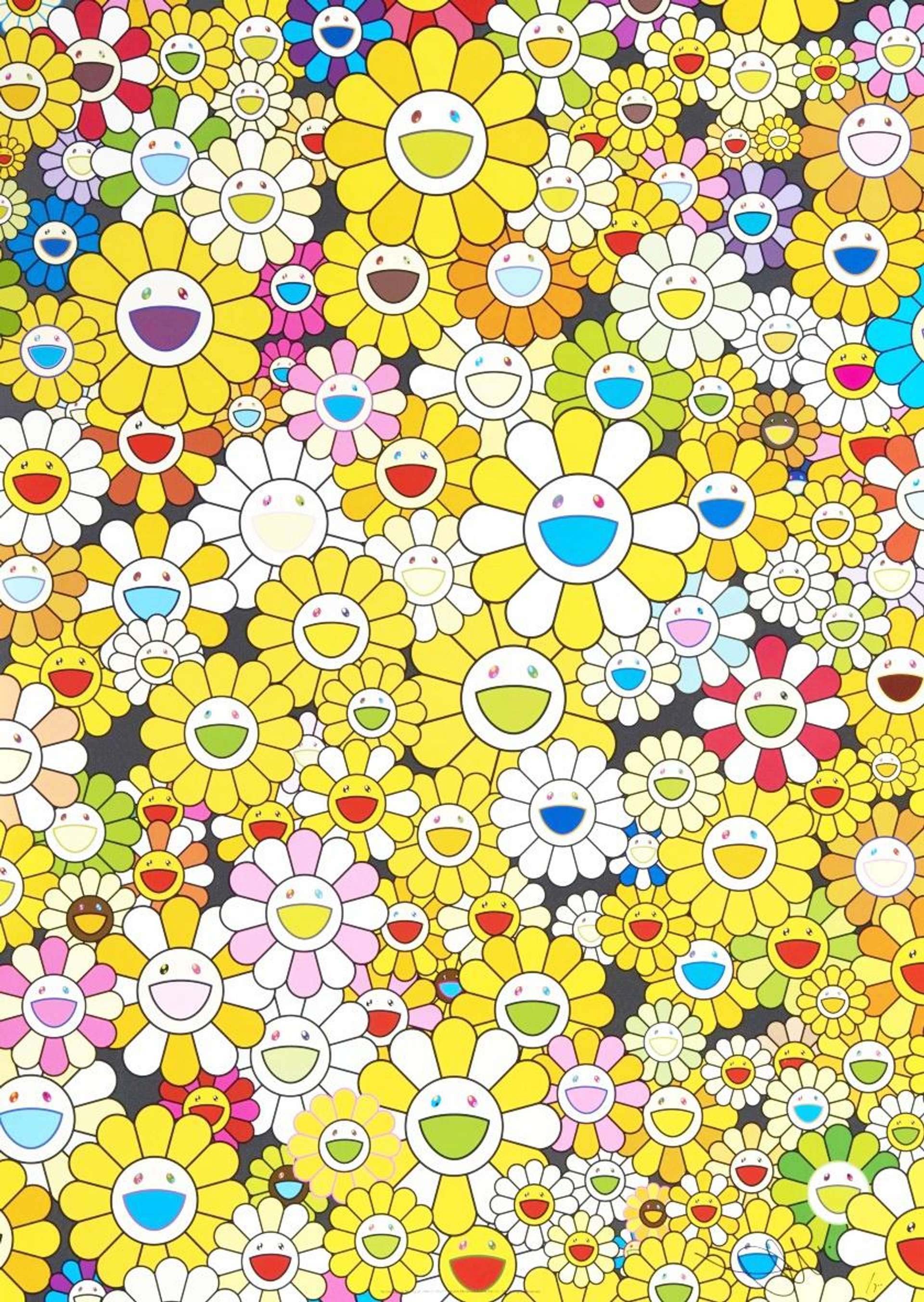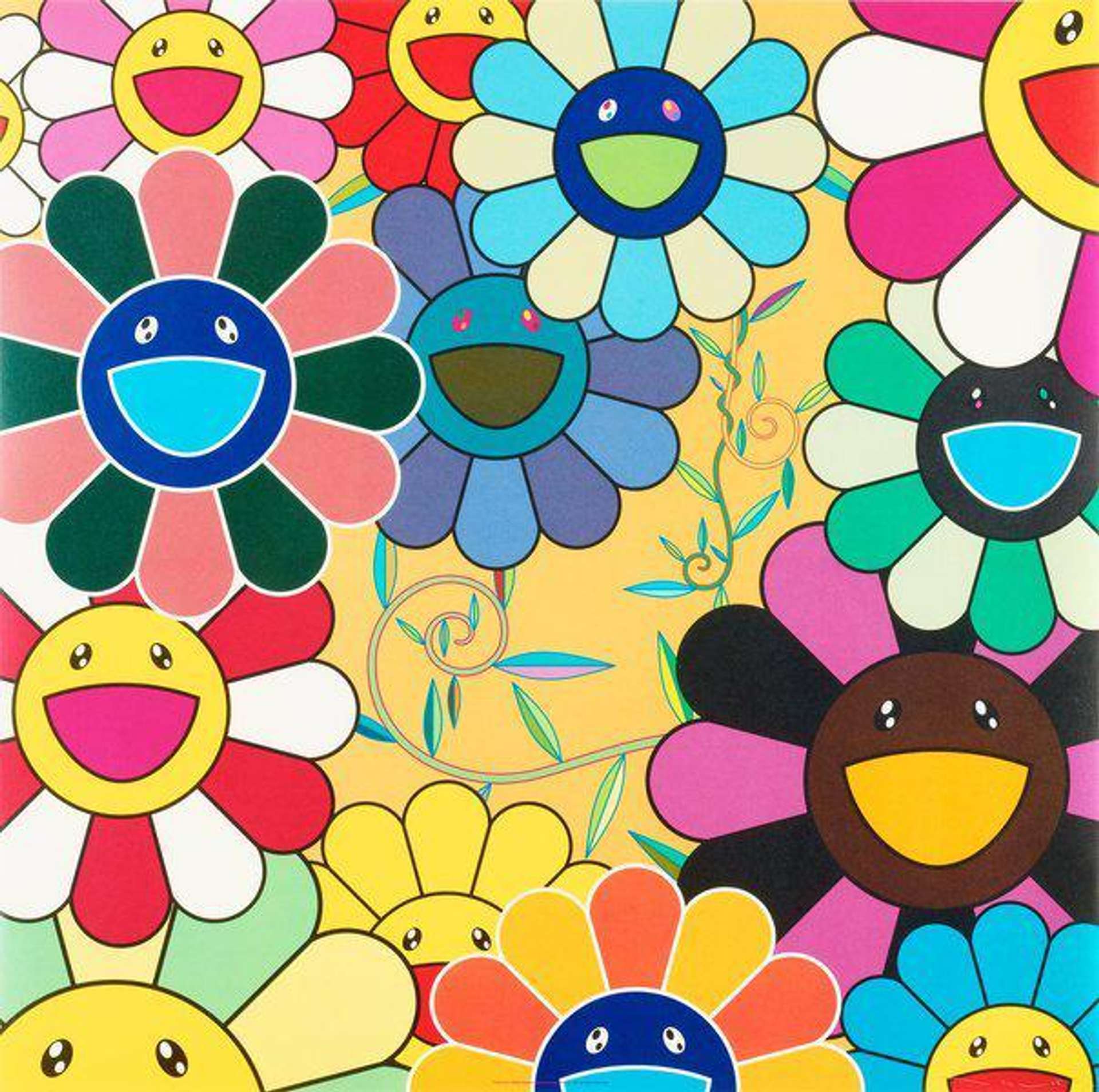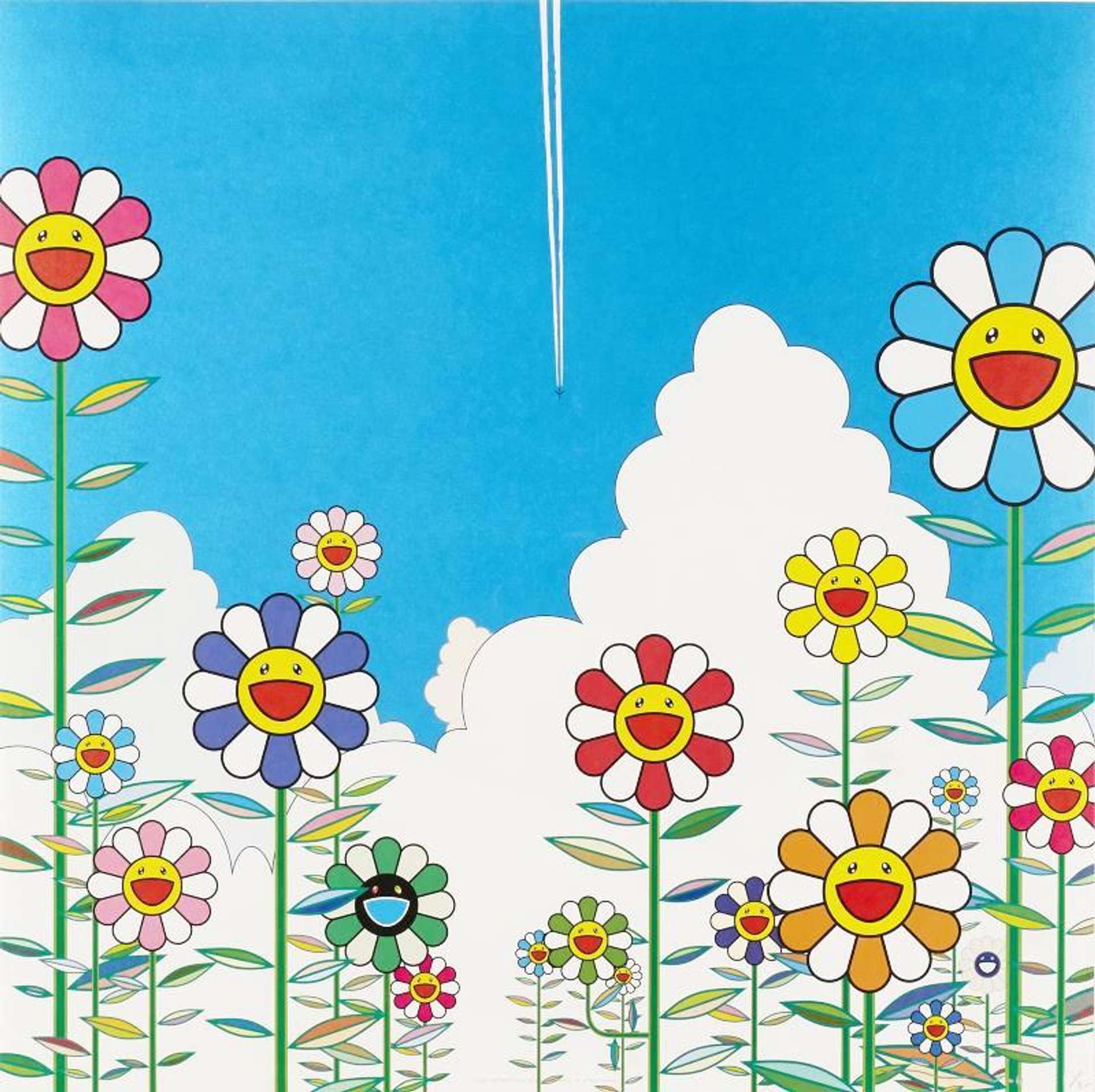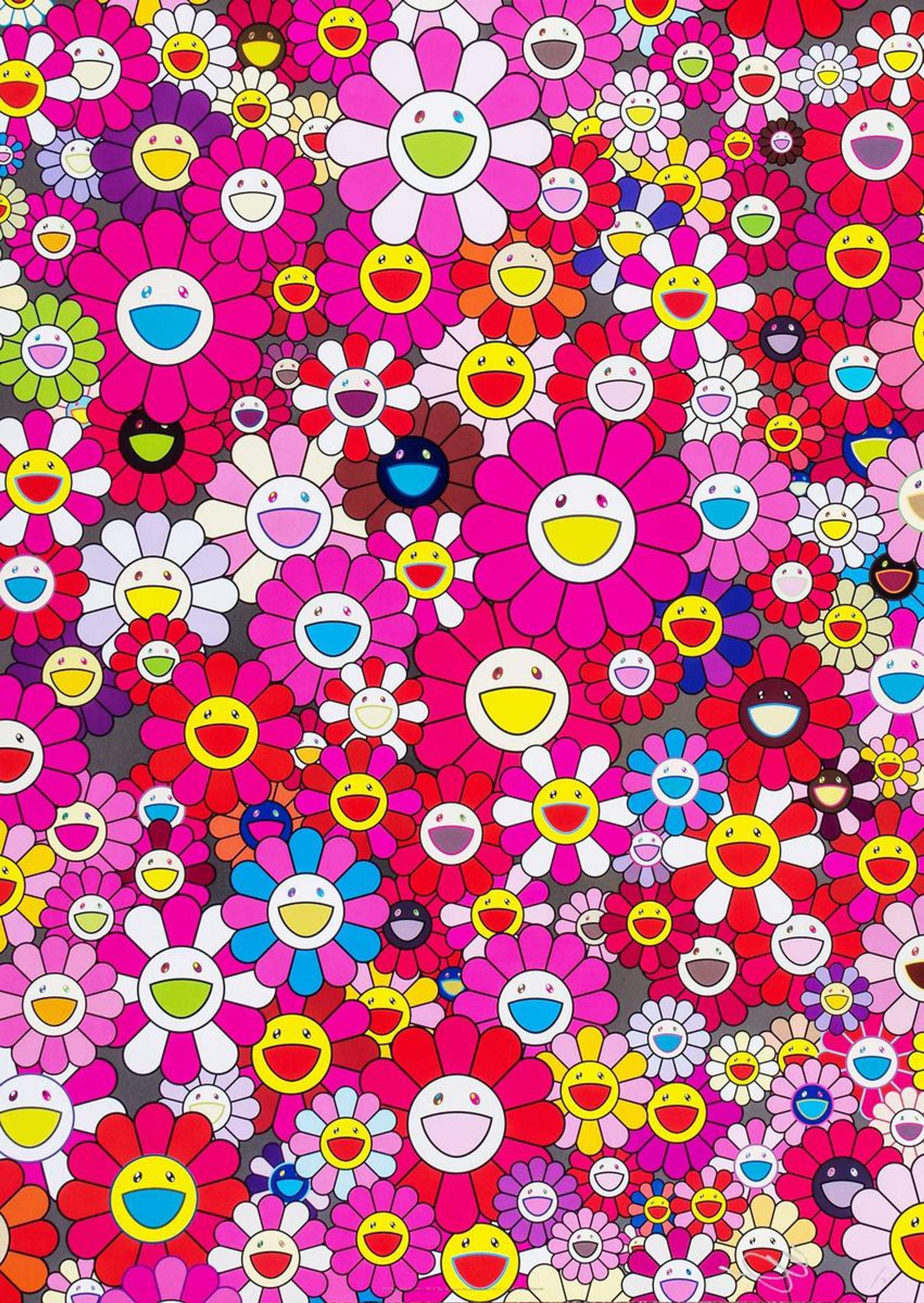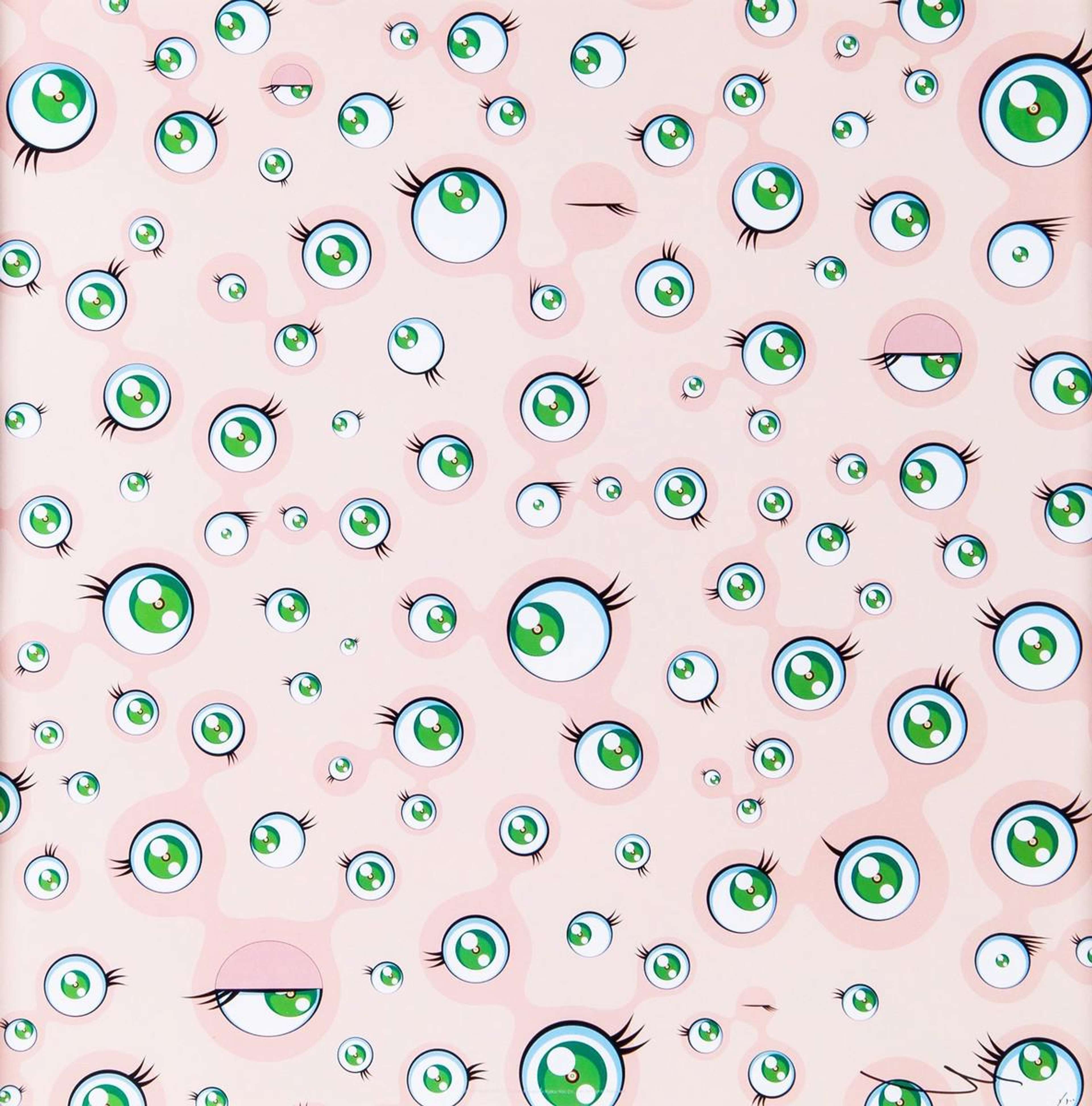 Kiki With Moss © Takashi Murakami 2003 Takashi Murakami’s Kiki With Moss.
Kiki With Moss © Takashi Murakami 2003 Takashi Murakami’s Kiki With Moss.
Takashi Murakami
252 works
Neo Pop artist Takashi Murakami, often likened to the iconic Andy Warhol, has made his own mark in the art world's collective consciousness. With his vibrant Superflat style, Murakami effortlessly combines the lines between traditional and avant-garde, East and West. His works, animated by influences from manga, anime, and Japanese culture, shimmer with bright hues and expressive characters that border playful and profound. From his collaborations with luxury brands to his deep meditations on post-war Japan, Murakami's artistry spans a broad and impactful spectrum.
A is for Anime
Murakami's work is heavily influenced by anime and manga, two of Japan's most popular cultural exports. His art blurs the boundaries between fine art and commercial visuals, taking inspiration from Japanese animated series and comic books to create vivid, intricate pieces that resonate with fans worldwide.
B is for Brand Collaborations
Murakami has an impressive record of brand partnerships, from designing a collection for Louis Vuitton to collaborations with musicians. These endeavours highlight his ability to bridge high art with popular culture, solidifying his status as a contemporary art icon.
C is for Colourful
Murakami's art is a testament to the power of vibrant hues, with radiant flowers and mesmerising backgrounds taking centre stage. While the initial allure might lie in the impressive array of colours, it's the underlying narratives that captivate. At first glance, it may seem overwhelming or distracting, but looking closer, it's evident that each shade is deliberately chosen to amplify his stories, guiding the viewer deeper into his vision.
D is for DOB
Mr. DOB is one of Murakami's most recognised characters, often considered his alter ego. With Mickey Mouse-like ears and a round face, Mr. DOB alters between cute and menacing, representing Murakami's exploration of the duality of joy and despair, innocence and malevolence.
E is for Entrepreneur
Beyond being an artist, Murakami is a successful entrepreneur. He founded Kaikai Kiki Co., Ltd., an art production and management company. Through this enterprise, he mentors upcoming artists, produces merchandise, organises exhibitions, and further extends his influence within the global art community.
F is for Flowers
Flowers, especially daisies with joyful faces, are recurring motifs in Murakami's oeuvre. They symbolise the nature of life and the themes of happiness and sadness. These iconic blossoms can be found gracing large canvases, sculptures, and even commercial products, reflecting Murakami's merger of art with commerce. A testament to their cultural and market impact, Flower Ball (Brown) sold for over £397,000 in 2009, underscoring the value and resonance of Murakami's floral imagery in the contemporary art world.
G is for Global Influence
Murakami's reach hasn’t been confined to Japan. His exhibitions have been showcased worldwide, from Paris to New York. Known for introducing Japanese pop culture to the broader art world, his global influence has reshaped discussions about contemporary art's boundaries and potential.
H is for Hiropon Factory
In the mid-1990s, Takashi Murakami founded the Hiropon Factory in Tokyo. This studio played a significant role in establishing his art production process and later evolved into Kaikai Kiki Co., Ltd. Here, young artists were trained, and Murakami's signature superflat style was developed and promoted, paving the way for his global influence in the contemporary art world.
I is for Icon
Beyond his works, Murakami himself has become an icon in pop culture. His signature flower motifs, use of bright colours, and collaborations with brands like Louis Vuitton have established him as a bridge between traditional art and modern consumer culture, making his imagery immediately recognisable to many.
 Image © The Broad / Flower Matango (b) Takashi Murakami 2006
Image © The Broad / Flower Matango (b) Takashi Murakami 2006J is for Juxtaposition
Murakami masterfully blends traditional Japanese painting techniques with contemporary themes. This juxtaposition is a hallmark of his work, drawing attention to the contrasts and similarities between the old and new. It's this duality, both in technique and content, that makes his work unique and compelling.
K is for Kaikai Kiki
After evolving from the Hiropon Factory, Kaikai Kiki Co., Ltd. became Murakami's art production and artist management company. Located in both Japan and New York, it’s more than just a studio—it's a hub for young artists, an incubator for talent, and a venue for promoting the superflat movement globally.
L is for Louis Vuitton
In the early 2000s, Murakami collaborated with fashion giant Louis Vuitton and designer Marc Jacobs. Together, they created a line of products featuring Murakami's vibrant designs, blurring the lines between art and fashion. This collaboration was a groundbreaking moment, reshaping luxury branding and solidifying Murakami’s place in pop culture.
M is for Music Collaborations
Takashi Murakami's artistic prowess extends beyond galleries and into the realm of music. He has forged significant collaborations with iconic musicians, including Kanye West, for whom he crafted the vibrant cover art of the Graduation album. These partnerships showcase Murakami's ability to transcend traditional art boundaries, fusing his unique aesthetic with the pulsating energy of the music world.
N is for Nihonga
Murakami was initially trained in Nihonga, a traditional style of Japanese painting. This early foundation greatly influenced his artistic direction. By combining Nihonga's techniques with contemporary themes, Murakami created a unique fusion that distinguishes his work from other contemporary artists.
O is for Otaku
Otaku culture, which refers to a dedicated and passionate fandom (often related to anime and manga), has been a significant influence on Murakami's work. By drawing from this subculture, he brings to the forefront the obsessions, aesthetics, and nuances of a community that's both celebrated and criticised in Japan.
P is for Pop Art
While deeply rooted in Japanese culture and traditions, Murakami's work is often compared to American Pop Art for its use of bright colours, commercial imagery, and commentary on consumer culture. Just as Warhol had his Soup Cans, Murakami has his smiling flowers, emphasising the universality of consumerism in modern society.
Q is for Quirky
Murakami's style has become synonymous with the quirky blend of contemporary pop culture and traditional Japanese art. This distinct approach has enabled him to craft pieces that are both strikingly modern and deeply rooted in tradition, creating art that resonates across generations and cultural boundaries.
R is for Rubber
Murakami's artistry isn't just confined to the canvas. In a rather unique collaboration, he designed a set of watches in partnership with Swiss luxury watchmaker Hublot. These rubber timepieces showcased not only Murakami's versatility but also his ability to translate his vibrant aesthetic into functional, everyday objects, making art accessible in new and unexpected ways.
S is for Superflat
A movement founded by Murakami himself, Superflat describes both the aesthetic characteristics of the Japanese artistic tradition and the nature of post-war Japanese culture and society. Superflat art often uses a flattened visual plane, merging various traditional and contemporary themes. This concept also speaks to the interplay between high and low art forms in Japan and the consumer-driven culture.
T is for Traditions
While Murakami is known for his contemporary outlook, his art deeply reveres and draws from Japanese traditions. This duality—melding the old with the new—sets him apart. Whether referencing ancient folklore or emulating the style of historic artists, Murakami ensures that Japan's rich past remains a vibrant part of his narrative.
U is for Ukiyo-e
Murakami often draws inspiration from Ukiyo-e, a genre of Japanese woodblock prints and paintings that flourished from the 17th through 19th centuries. While his works are undoubtedly contemporary, they echo the themes and styles of these historic prints, bridging the gap between Japan's artistic past and its present. This homage to Ukiyo-e is a testament to Murakami's deep respect for traditional art forms even as he reshapes them for the modern world.
V is for Visionary
Murakami's approach to art is visionary. This perspective has led to groundbreaking exhibitions, unexpected collaborations with brands and celebrities, and the integration of art into everyday life. His visionary stance has consistently challenged conventions, making him a trailblazer in contemporary art.
W is for Warhol
Andy Warhol's influence on Murakami is evident. Both artists blur the lines between fine art and commercialism, with Murakami frequently drawing parallels between himself and Warhol. Their shared affinity for mass production and a keen understanding of the power of branding has established Murakami as a successor to Warhol's legacy in the contemporary art world.
X is for Xanadu
Murakami's distinct edge lies in his ability to marry traditional techniques with present-day narratives and aesthetics. This singularity has cemented his position in the international art arena, making his creations unmistakable. Such a magnetic pull is what attracts aficionados, collectors, and global collaborators to the vibrant world of his art.
Y is for Youth Culture
A significant influence on Murakami's art and ethos is the fascination with youth culture. Drawing from pop culture, fashion, and the evolving trends of younger generations, he captures the essence of contemporary life and its transient nature. His frequent collaborations with musicians, designers, and other artists further embed his work within the zeitgeist of youth culture, ensuring its relevance and resonance with younger audiences.
Z is for Zen
Despite the colourful chaos present in many of his pieces, there is an underlying Zen philosophy in Murakami's art. Drawing from traditional Japanese beliefs and practices, he often incorporates elements that hint at a deeper spiritual reflection. Whether through meditative patterns, motifs borrowed from nature, or the calm demeanour of some characters, Murakami subtly integrates Zen concepts, offering a serene counterpoint to his otherwise vibrant works.





